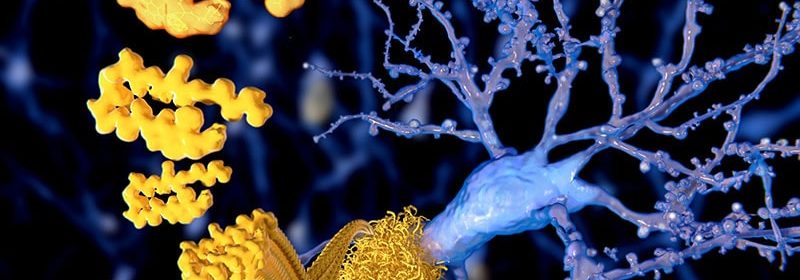spironolactone dogs heart failure

Final results of the pivotal twin phase 3 studies of gantenerumab in early Alzheimer’s disease (AD) confirm that the investigational antiamyloid agent lowered amyloid plaque burden but did not slow clinical decline in patients with early AD.
Preliminary results from the GRADUATE I and II trials were released about a year ago by the manufacturer, as reported by Medscape Medical News. The full trial data were published online November 15 in the New England Journal of Medicine.
GRADUATE I and II evaluated the safety and efficacy of gantenerumab (Genentech/Roche) compared with placebo over 27 months in 1965 adults with mild cognitive impairment (MCI) or mild dementia due to AD and evidence of amyloid plaques on PET imaging or cerebrospinal fluid (CSF) testing.
The primary outcome was the change from baseline at week 116 in the score on the Clinical Dementia Rating scale-Sum of Boxes (CDR-SB; range, 0 to 18, with higher scores indicating greater cognitive impairment).
The baseline CDR-SB score was 3.7 in GRADUATE I participants and 3.6 in GRADUATE II participants. At week 116, there was no significant difference between the gantenerumab and placebo groups in change from baseline in the CDR-SB score.
At week 116, the change from baseline in the CDR-SB score was 3.35 with gantenerumab and 3.65 with placebo in the GRADUATE I trial (difference, sonhar co urso –0.31; 95% CI, –0.66 to 0.05; P = .10) and 2.82 and 3.01, respectively, in the GRADUATE II trial (difference, –0.19; 95% CI, –0.55 to 0.17; P = .30).
“When the analysis of the primary outcome was based on pooled data from both trials, the results were generally consistent with the results from the primary analysis in each trial,” report Randall J. Bateman, MD, professor of neurology, Washington University School of Medicine, St Louis, Missouri, and coauthors.
Results for secondary clinical outcomes also did not support a beneficial clinical effect of the drug.
Gantenerumab led to partial removal of amyloid plaques and improvement in some soluble biomarkers of AD, but the magnitude of amyloid plaque removal was “smaller than expected,” the researchers note.
At week 116, the difference in amyloid levels on PET between gantenerumab and placebo was –66.44 and –56.46 centiloids in the GRADUATE I and II trials, respectively. Amyloid-negative status was attained in 28.0% and 26.8% of participants receiving gantenerumab in the two trials.
Across both trials, patients taking gantenerumab had lower CSF levels of phosphorylated tau 181 and higher levels of amyloid beta-42 than those taking placebo. The accumulation of aggregated tau on PET was similar in the two groups.
Amyloid-related imaging abnormalities with edema (ARIA-E) occurred in 24.9% of participants receiving gantenerumab. Most cases were asymptomatic, with central nervous system symptoms associated with ARIA-E occurring in only 5.0%, and there were no deaths associated with ARIA-E.
Discouraging Data, Promising Pipeline
In a statement sent to Medscape Medical News, Howard Fillit, MD, founding executive director of the Alzheimer’s Drug Discovery Foundation (ADDF), said that although the gantenerumab study failed to meet its primary endpoints, the data are “supportive of the need to diagnose and begin therapeutic interventions earlier in the disease when treatments can provide the most benefits to patients by slowing the progression of the disease,” he said.
“Nonetheless, there is a growing consensus in the field that optimal Alzheimer’s treatment strategies will require an arsenal of drugs that target the broader underlying biology of the disease in addition to clearing amyloid plaques,” said Fillit, who was not involved in the studies.
“Today’s drug pipeline is incredibly promising, where around 75% of drugs in development are targeting novel pathways based on the biology of aging including inflammation, metabolic disturbances, vascular disease, and more,” Fillit added.
“Like with cancer, the goal is to develop multiple drugs that can be used in combination with one another for a precision-medicine approach based on each patient’s individual biomarker profile, ultimately stopping Alzheimer’s in its tracks,” he said.
At the end of the day, Fillit said, it’s important to remember that scientific research is “an iterative process, and it is clear from this trial and others that years of relentless work by Alzheimer’s researchers has brought us into the modern era of research.”
“We now have the capabilities to conduct more rigorous, biomarker-powered trials, allowing us to measure the effectiveness of the next generation of drugs and bring them to market more efficiently than ever for the millions of patients and their loved ones living with Alzheimer’s,” Fillit said.
The GRADUATE I and II trials were funded by F. Hoffman-La Roche. Disclosure forms provided by the authors are available with the full text of the article at NEJM.org. Fillit has reported no relevant financial relationships.
N Engl J Med. Published online November 15, 2023. Abstract
Source: Read Full Article